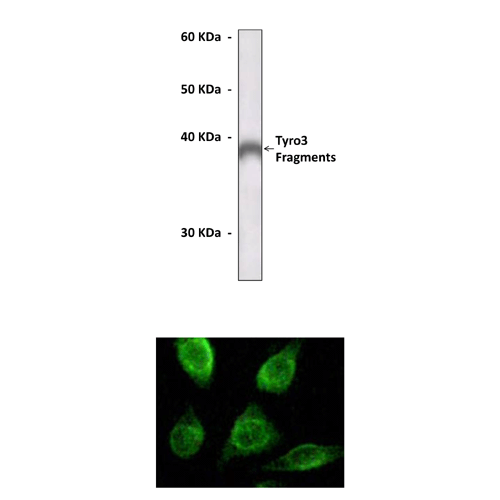Anti-Tyro3: Mouse Tyro3 Antibody |
 |
BACKGROUND Tyro3 belongs to the TAM (Tyro3, Axl, and Mer) family of receptor tyrosine kinases. Growth Arrest Specific gene 6 (Gas6) and in some tissues the closely related Protein S (ProS1), a serum protein involved in the coagulation cascade, are ligands for the TAM family members. The TAM receptors are normally expressed in a cell- and tissue-specific manner. Some tissues express all the family members, whereas others express selected receptors and/or their ligands. The mechanism of action for the TAM family is complex due to of the ability of the receptors to form hetero- as well as homodimers and the ability of Gas6 and/or ProS1 to not only interact with and signal through the full-length receptor, but to also bind extracellular domain fragments to promote or antagonize signaling.1 TAM family members play important regulatory roles in a variety of tissues, including the central nervous, reproductive, immune, and vascular systems and in a number of major cellular processes: cell survival and proliferation, immunomodulation and phagocytosis. The interaction between Axl and Gas6 has been implicated in cell adhesion processes, prevention of apoptosis, and cell proliferation, whereas Tyro3-Gas6 signaling was reported to stimulate osteoclastic bone resorption. In fibroblasts, high expression of Tyro3 or Axl has been found to cause transformation even in the absence of the ligand. Additionally, Axl, Tyro3 and Mer transmit signals that are essential for the generation of a functional NK cell repertoire. Overexpression of the TAM family proteins has also been observed in a variety of cancers. A number of different phenotypes are observed in mice lacking individual or all three receptors. With aging, Tyro3-null mice develop cerebellar ataxia, and immune defects are observed with the progressive loss of the TAM family, especially those including Mer. Interstingly, it was shown that TLR signaling up-regulates TAM receptors by inducing interferon production and Stat1 activation which stimulate TAM receptor expression. However, TAM receptors play important role in inhibiting TLR signaling by inducing production of SOCS1 and SOCS3. This process allows the innate immune response to be launched but ultimately ensures that it is self-limiting and therefore not detrimental to the host.2
As for all RTKs, ligand-induced signal transduction is expected to be the main mechanism by which the Axl/Tyro3 family members exert their biological functions. It is also possible that additional mechanisms exist by which the Axl/Tyro3 receptors function, and these mechanisms might not involve signaling through activation of the tyrosine kinase activity but rather cell adhesion processes. It was shown that Gas6 induced the phosphorylation of Tyro3 in cortical neurons in vitro, resulting in the recruitment of the mitogen-activated protein kinase (MAPK) and the phosphoinositide-3 kinase (PI(3)K) signaling pathways. As these pathways play critical roles in the induction of hippocampal long-term potentiation (LTP), thus, Tyro3 signaling may influence synaptic plasticity in the dendritic compartment of hippocampal and cortical neurons.3 In addition TAM receptors may collaborate with other receptor signaling. It was reported that both Tyro3 and Axl receptors are upregulated by NGF on the differentiating PC12, where they collaborate with TrkA to support neuronal differentiation and survival.4 Finally, GAS6 binds to phosphatidylserine on the outer leaflet of an apoptotic cell and may serve as a bridging molecule between Axl/Mertk/Tyro3 family receptors on phagocytes and the apoptotic cell, to activate macrophages and dendritic cells for clearance of apoptotic cells.5
As for all RTKs, ligand-induced signal transduction is expected to be the main mechanism by which the Axl/Tyro3 family members exert their biological functions. It is also possible that additional mechanisms exist by which the Axl/Tyro3 receptors function, and these mechanisms might not involve signaling through activation of the tyrosine kinase activity but rather cell adhesion processes. It was shown that Gas6 induced the phosphorylation of Tyro3 in cortical neurons in vitro, resulting in the recruitment of the mitogen-activated protein kinase (MAPK) and the phosphoinositide-3 kinase (PI(3)K) signaling pathways. As these pathways play critical roles in the induction of hippocampal long-term potentiation (LTP), thus, Tyro3 signaling may influence synaptic plasticity in the dendritic compartment of hippocampal and cortical neurons.3 In addition TAM receptors may collaborate with other receptor signaling. It was reported that both Tyro3 and Axl receptors are upregulated by NGF on the differentiating PC12, where they collaborate with TrkA to support neuronal differentiation and survival.4 Finally, GAS6 binds to phosphatidylserine on the outer leaflet of an apoptotic cell and may serve as a bridging molecule between Axl/Mertk/Tyro3 family receptors on phagocytes and the apoptotic cell, to activate macrophages and dendritic cells for clearance of apoptotic cells.5
REFERENCES
1. Seitz, H.M. et al: J. Immunol. 178:5635-42, 2007
2. O’neill, L.A.J.: Cell 131:1039-41, 2007
3. Prieto, A.L. et al: Neurosci. 150:319-34, 2007
4. Zheng, Y. et al: Biochem. Biophys. Res. Commun. 378:371-5, 2009
5. Curtis, J.L.: Front Biosci. 14:2631-46, 2009
2. O’neill, L.A.J.: Cell 131:1039-41, 2007
3. Prieto, A.L. et al: Neurosci. 150:319-34, 2007
4. Zheng, Y. et al: Biochem. Biophys. Res. Commun. 378:371-5, 2009
5. Curtis, J.L.: Front Biosci. 14:2631-46, 2009
Products are for research use only. They are not intended for human, animal, or diagnostic applications.
Параметры
Cat.No.: | CP10243 |
Antigen: | Purified recombinant human Tyro3 fragments expressed in E. coli. |
Isotype: | Mouse IgG1 |
Species & predicted species cross- reactivity ( ): | Human |
Applications & Suggested starting dilutions:* | WB 1:1000 IP n/d IHC n/d ICC 1:200 FACS n/d |
Predicted Molecular Weight of protein: | 120 kDa |
Specificity/Sensitivity: | Detects endogenous Tyro3 proteins without cross-reactivity with other family members. |
Storage: | Store at -20°C, 4°C for frequent use. Avoid repeated freeze-thaw cycles. |
*Optimal working dilutions must be determined by end user.
Документы
Информация представлена исключительно в ознакомительных целях и ни при каких условиях не является публичной офертой








